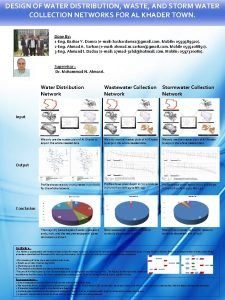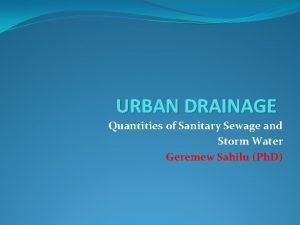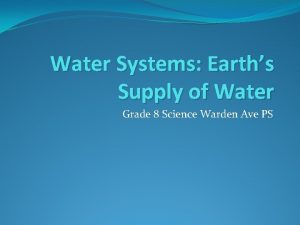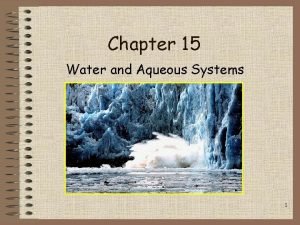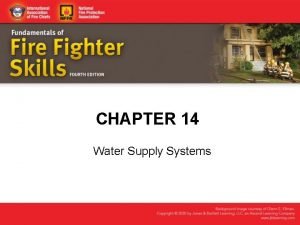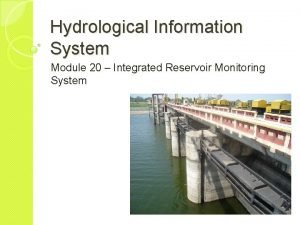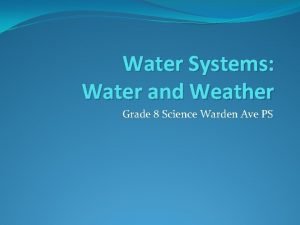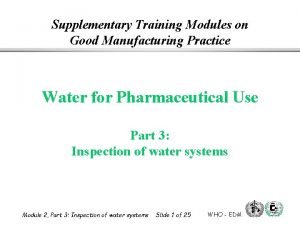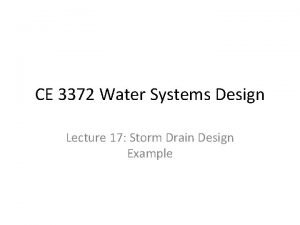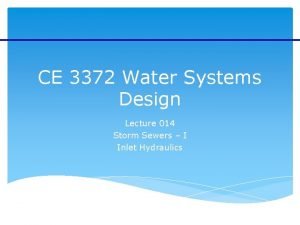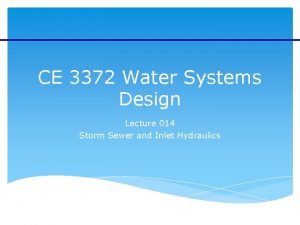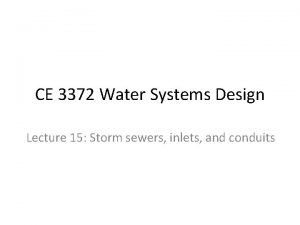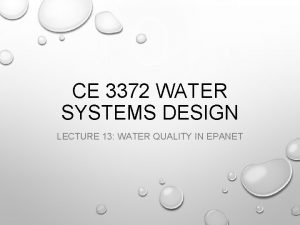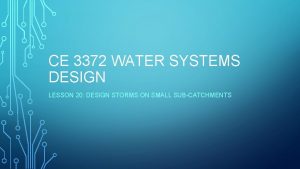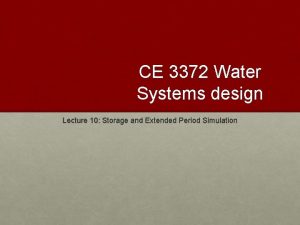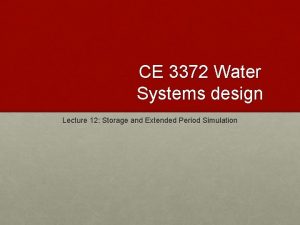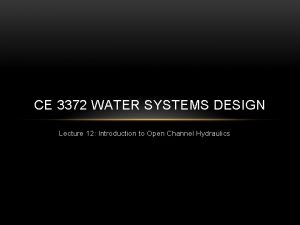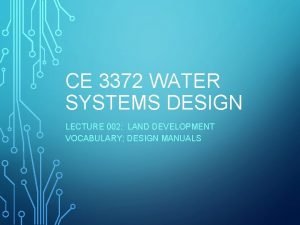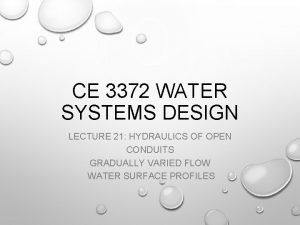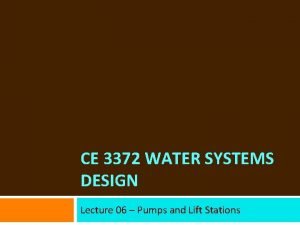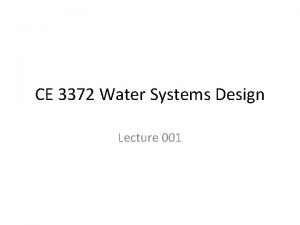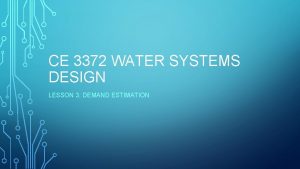CE 3372 Water Systems Design Lecture 18 Storm































- Slides: 31

CE 3372 Water Systems Design Lecture 18: Storm sewers, inlets, conduits and related hydrology and hydraulics

Storm Sewers • Inlets to capture runoff • Conduits to convey to outfall – Lift Stations if cannot gravity flow to outfall – Detention and diversions • Outfall release back into environment 2

Storm Sewer Systems Inlets Lift Station Conduits

Storm Sewer Inlets • Spread width • Combination Inlet – Curb+Grate • Carryover – Flow that passes beyond the inlet (none in this picture – complete capture) 4

Storm Sewers • Inlets capture stormwater • Junctions connect laterals to trunk lines. • Conduits (pipes) convey water to outfall

Design Flow • A design flow is the anticipated discharge for a specified AEP. – Typically 2 -yr – 5 yr AEP for subdivision type of drainage. – 50 -yr for major highways • Storm sewers may have extra capacity (ability to convey more than the design flow) – but are not expected to completely drain during flows in excess of design flow.

Conduit Sizing • Determine design flow required for a conduit (hydrology and continuity) • ASSUME pipe will be full (but not pressurized) – apply Manning’s equation to solve for diameter

Inlet Sizing • Determine allowable depth at inlet – Consider ponded width at the inlet – Hydrology to determine discharge that the inlet(s) must capture • Apply appropriate equation(s) to size inlet to achieve complete or partial capture. – Partial, then need to route carryover to next downstream inlet.

Inlet Sizing • Alternative is to determine capacity of inlets of known sizes (10 -foot, 15 -foot, …) • Then apply hydrology to determine the area that the inlet can serve – Assumes you will grade that entire area to drain to the inlet.

Junctions • Junctions are to connect pipes – Use drops to control velocity – Use to change pipe sizes – pipes get bigger moving downstream.

Example 0. 5 Acres S=0. 006 Parking 200 ft 1. 73 acres S= 0. 005 Residential 1. 2 acres S=0. 006 Grass 400 ft • 3 drainage areas -> 3 inlets • 4 conduits to outfall 300 ft 600 ft

Inlets • • • Suppose all will be curb-on-grade Cross slope in streets is 2% (typical). Longitudinal slope is 0. 5%. Allowable depth is 6 -inches. Design AEP is 2 -yr • Calculate capacity for 5 foot, 10 foot, and 15 foot inlets.

Inlets

Inlets

Inlets

Inlets • 5 foot = 1 CFS • 10 foot = 3. 36 CFS • 15 foot = 6. 63 CFS

Inlet Hydrology • Compute Tc for each area to each inlet location – About 1. 5 ft/sec for the parking lot. – About 0. 5 ft/sec for the grass area. – The residential would be between – 0. 75 ft/sec.

Inlet Hydrology • Parking lot

Inlet Hydrology • Grass Area

Inlet Hydrology • Residential

Inlet Hydrology • Inlet Times – Grass = 10. 8 minutes – Parking Lot = 10 minutes – Residential = 10 minutes • Runoff Coefficients – Grass = 0. 35 – Parking Lot = 0. 95 – Residential = 0. 50

Inlet Hydrology

Inlet Hydrology

Conduit Design 0. 5 Acres S=0. 006 Parking 200 ft 1. 73 acres S= 0. 005 Residential 1. 2 acres S=0. 006 Grass 400 ft • 4 conduits to outfall 300 ft 600 ft

Conduit Design – 200 ft – Q = 3. 23 cfs • Diameter: – 1. 15 ft 0. 5 Acres S=0. 006 Parking 200 ft • Conduit #1

Conduit Design • Conduit #2 – 300 ft – Q = 2. 86 cfs 1. 2 acres S=0. 006 Grass • Diameter: – 1. 1 ft 300 ft

Conduit Design 0. 5 Acres S=0. 006 Parking 200 ft 1. 2 acres S=0. 006 Grass 400 ft • Conduit #3 • Takes flow from 1 and 2 • Use accumulated Tc and C*A to approximate arrival time for different peaks • 400 ft • Q=5. 46 cfs • D=1. 46 ft 300 ft

Conduit Design 200 ft 1. 2 acres S=0. 006 Grass 400 ft • Conduit #4 • Takes flow from 3 and 0. 5 Acres Residential S=0. 006 Parking • Use accumulated Tc and C*A to approximate different peak flow arrival times 1. 73 acres S= 0. 005 • 600 ft Residential • Q =10. 7 cfs • D =1. 81 ft 300 ft 600 ft

Conduit Design • Then specify nominal pipe sizes – Conduit #1= 1. 15 ft (13. 8 inches) Use: 16 inch – Conduit #2= 1. 1 ft (13. 1 inches) Use: 16 inch – Conduit #3= 1. 46 ft (17. 5 inches) Use: 18 inch – Conduit #4= 1. 81 t (21. 7 inches) Use: 24 inch • Set elevations (assumed slope in the example – but it would depend on the outfall invert elevation) • Check hydraulics if outfall is not a free drop.

Conduit Design • Trickiest part is to accept the accumulating C*A value in rational method. • As we move downstream in the network, the pipes are “outlets” for a watershed that is comprised of ever increasing area and Tc. • The method is an approximation to account for different arrival times of the peaks from different parts of the watershed

Conduit Design • Check hydraulics using SWMM – Steady if the outfall is free (drops) – Dynamic if outfall is submerged (backwater)
 Proxyvo
Proxyvo Water and water and water water
Water and water and water water Storm water distribution design
Storm water distribution design 01:640:244 lecture notes - lecture 15: plat, idah, farad
01:640:244 lecture notes - lecture 15: plat, idah, farad Quantity of sanitary sewage
Quantity of sanitary sewage Design storm in hydrology
Design storm in hydrology Operating system lecture notes
Operating system lecture notes Lecture sound systems
Lecture sound systems Lecture sound systems
Lecture sound systems Anchorage length eurocode
Anchorage length eurocode Urban design lecture
Urban design lecture Elements of design in interior design ppt
Elements of design in interior design ppt Lecture hall background
Lecture hall background Game design lecture
Game design lecture Computer aided drug design lecture notes
Computer aided drug design lecture notes Cmos vlsi design lecture notes
Cmos vlsi design lecture notes Decision support systems and intelligent systems
Decision support systems and intelligent systems Dicapine
Dicapine Embedded systems vs cyber physical systems
Embedded systems vs cyber physical systems Elegant systems
Elegant systems Water systems grade 8
Water systems grade 8 Wells water systems recently reported
Wells water systems recently reported Grade 8 water systems test
Grade 8 water systems test Water and aqueous systems chapter 15 answers
Water and aqueous systems chapter 15 answers Chapter 15 water and aqueous systems
Chapter 15 water and aqueous systems Chapter 14 water supply systems
Chapter 14 water supply systems Chapter 15 water and aqueous systems
Chapter 15 water and aqueous systems Reservoir monitoring system
Reservoir monitoring system Grade 8 science water systems
Grade 8 science water systems Pharmaceutical water system training
Pharmaceutical water system training Advantages of direct cold water system
Advantages of direct cold water system Lotic water system
Lotic water system


